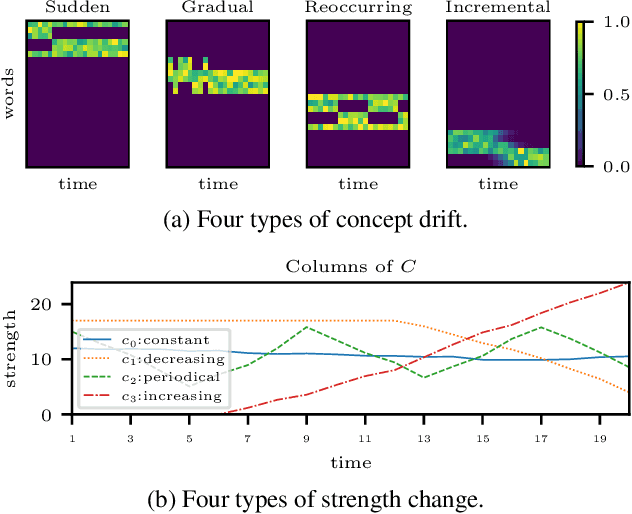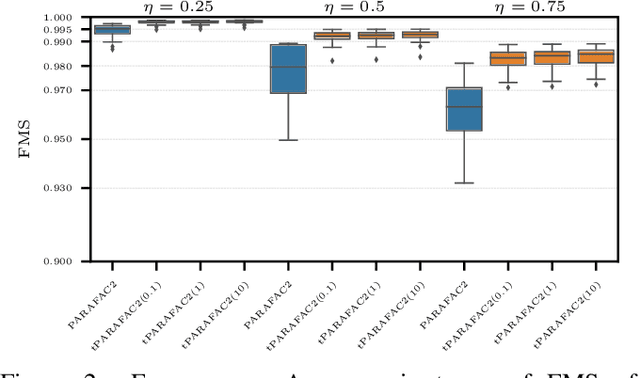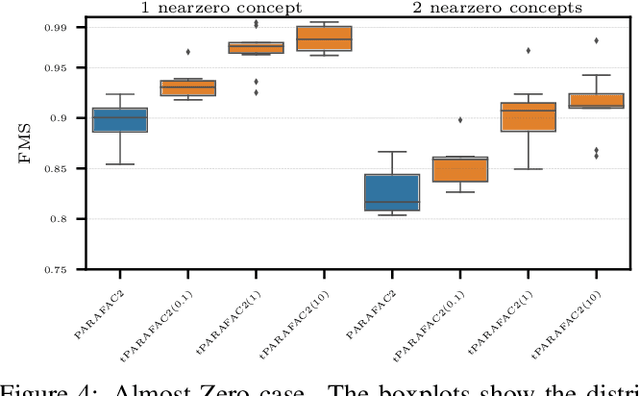Christos Chatzis
dCMF: Learning interpretable evolving patterns from temporal multiway data
Feb 26, 2025


Abstract:Multiway datasets are commonly analyzed using unsupervised matrix and tensor factorization methods to reveal underlying patterns. Frequently, such datasets include timestamps and could correspond to, for example, health-related measurements of subjects collected over time. The temporal dimension is inherently different from the other dimensions, requiring methods that account for its intrinsic properties. Linear Dynamical Systems (LDS) are specifically designed to capture sequential dependencies in the observed data. In this work, we bridge the gap between tensor factorizations and dynamical modeling by exploring the relationship between LDS, Coupled Matrix Factorizations (CMF) and the PARAFAC2 model. We propose a time-aware coupled factorization model called d(ynamical)CMF that constrains the temporal evolution of the latent factors to adhere to a specific LDS structure. Using synthetic datasets, we compare the performance of dCMF with PARAFAC2 and t(emporal)PARAFAC2 which incorporates temporal smoothness. Our results show that dCMF and PARAFAC2-based approaches perform similarly when capturing smoothly evolving patterns that adhere to the PARAFAC2 structure. However, dCMF outperforms alternatives when the patterns evolve smoothly but deviate from the PARAFAC2 structure. Furthermore, we demonstrate that the proposed dCMF method enables to capture more complex dynamics when additional prior information about the temporal evolution is incorporated.
tPARAFAC2: Tracking evolving patterns in (incomplete) temporal data
Jul 01, 2024Abstract:Tensor factorizations have been widely used for the task of uncovering patterns in various domains. Often, the input is time-evolving, shifting the goal to tracking the evolution of underlying patterns instead. To adapt to this more complex setting, existing methods incorporate temporal regularization but they either have overly constrained structural requirements or lack uniqueness which is crucial for interpretation. In this paper, in order to capture the underlying evolving patterns, we introduce t(emporal)PARAFAC2 which utilizes temporal smoothness regularization on the evolving factors. We propose an algorithmic framework that employs Alternating Optimization (AO) and the Alternating Direction Method of Multipliers (ADMM) to fit the model. Furthermore, we extend the algorithmic framework to the case of partially observed data. Our numerical experiments on both simulated and real datasets demonstrate the effectiveness of the temporal smoothness regularization, in particular, in the case of data with missing entries. We also provide an extensive comparison of different approaches for handling missing data within the proposed framework.
A Time-aware tensor decomposition for tracking evolving patterns
Aug 15, 2023



Abstract:Time-evolving data sets can often be arranged as a higher-order tensor with one of the modes being the time mode. While tensor factorizations have been successfully used to capture the underlying patterns in such higher-order data sets, the temporal aspect is often ignored, allowing for the reordering of time points. In recent studies, temporal regularizers are incorporated in the time mode to tackle this issue. Nevertheless, existing approaches still do not allow underlying patterns to change in time (e.g., spatial changes in the brain, contextual changes in topics). In this paper, we propose temporal PARAFAC2 (tPARAFAC2): a PARAFAC2-based tensor factorization method with temporal regularization to extract gradually evolving patterns from temporal data. Through extensive experiments on synthetic data, we demonstrate that tPARAFAC2 can capture the underlying evolving patterns accurately performing better than PARAFAC2 and coupled matrix factorization with temporal smoothness regularization.
 Add to Chrome
Add to Chrome Add to Firefox
Add to Firefox Add to Edge
Add to Edge